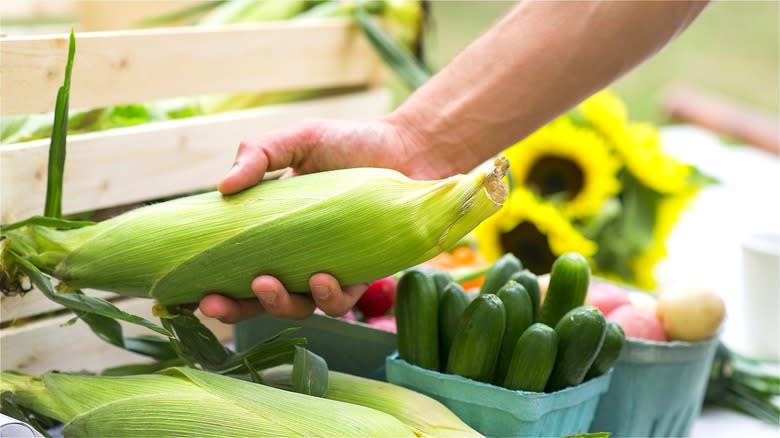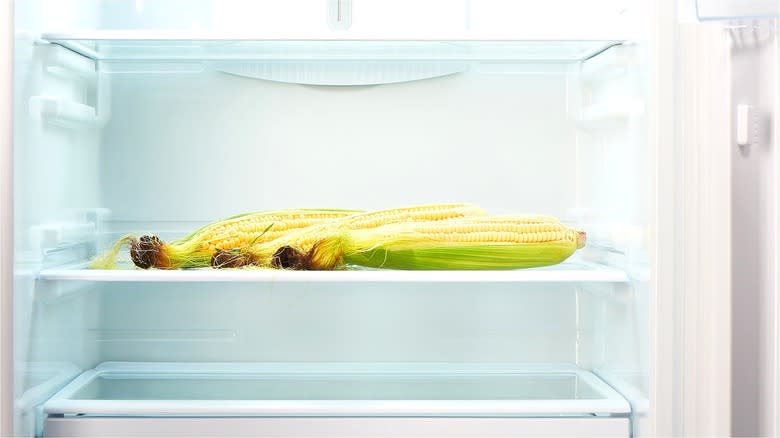This Is The Easiest Way To Tell If Your Corn Is Ripe

There's no better complement to an outdoor meal than a platter of grilled corn on the cob. Sweet, juicy, and full of summer flavor, ripe corn on the cob is one of the season's greatest gifts. Whether you're grabbing a bunch of ears at a local farmer's market or picking up a few cobs at your nearest grocery store, there is one surefire way to tell whether or not these warm weather delicacies are ripe for eating. Upon harvest, corn's natural sweetness slowly degrades and converts to starch, giving you only a short amount of time to enjoy corn at its peak.
To determine if your corn is ripe, peel back a portion of a cob's husk and silk. Then pierce raw kernels with your fingernail or a sharp knife. A perfectly ripe kernel will emit a milky white liquid when cut. This white substance indicates that your corn is in prime condition for eating. Conversely, a white substance that resembles more of a thick white paste rather than a milky liquid is an indication that your corn has moved past the point of consumption. On the other hand, if pierced kernels produce a clear liquid, your corn was unfortunately picked before fully ripening. Next to producing milky juice, there are additional ways to spot perfectly ripe corn.
Read more: 12 Vegetables And Fruits That Used To Look Very Different
More Ways To Identify Ripe Corn On The Cob

The creamy liquid that seeps out of ripe corn is a reliable sign that your favorite summer vegetable is ready to enjoy. The kernel milk stage or roasting ear stage takes place three weeks after corn develops silk on the stalk. Corn only exists in this state for roughly five to six days before moving to the kernel dough stage where that milky white substance turns thick and starchy. The kernel milk stage is when all corn is typically harvested. Unfortunately, corn does not continue to ripen after it has been picked from the stalk. Therefore, it's essential for you to use your best judgment when choosing ears from a farm stand or grocery store.
Among the many ways to tell if summer foods are ripe, appearance plays a bigger role than you might assume. If you don't feel comfortable peeling back husks and piercing raw ears of corn in the middle of a supermarket, the included silk and husks also provide a lot of information regarding ripeness. Corn silk should be golden yellow as opposed to dark in color. The husks should have a vibrant green hue with a smooth lively finish. Husks that have browned or wilted may be an indication of corn that has passed its peak. Even though the ripening window for corn is short-lived, there are a few ways you can extend the shelf life of this fresh summer vegetable at home.
How To Maintain The Freshness Of Ripe Corn On The Cob

Ideally, fresh corn should be consumed within a few days. When corn is harvested, the transformation from sugar to starch begins, giving you only a small window of time to enjoy the most flavorful version of this summertime vegetable. Fortunately, there are a few effective ways to store corn on the cob to maintain its fresh quality and flavor. If you don't have plans to consume ripened ears on the day of purchase, store unhusked corn in your refrigerator. Alternatively, if you decide to peel and remove husks and silk, store clean ears in a plastic bag to retain moisture. Choosing one of these storage methods will extend the shelf life of your corn up to two days.
For those of you who wish to enjoy fresh corn at a later date, freezing is the best option. Remove husks and silk, freezing whole ears in freezer-safe plastic bags. To preserve more of that sweet, ripe flavor, consider blanching corn before freezing. You can also freeze cut kernels. If stored with precision, raw frozen corn lasts up to a year.
Luckily, you have more than one convenient way to store ripe corn on the cob. However, make sure you're taking care when selecting fresh ears and choose corn with green husks and golden silk. Corn is ready to eat when milky white juice can be found within the sweet, buttery kernels.
Read the original article on The Daily Meal.


